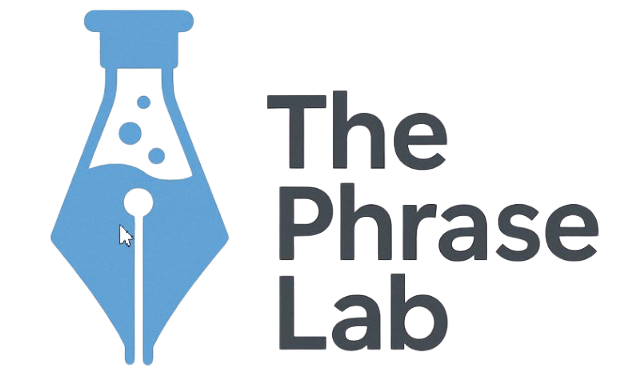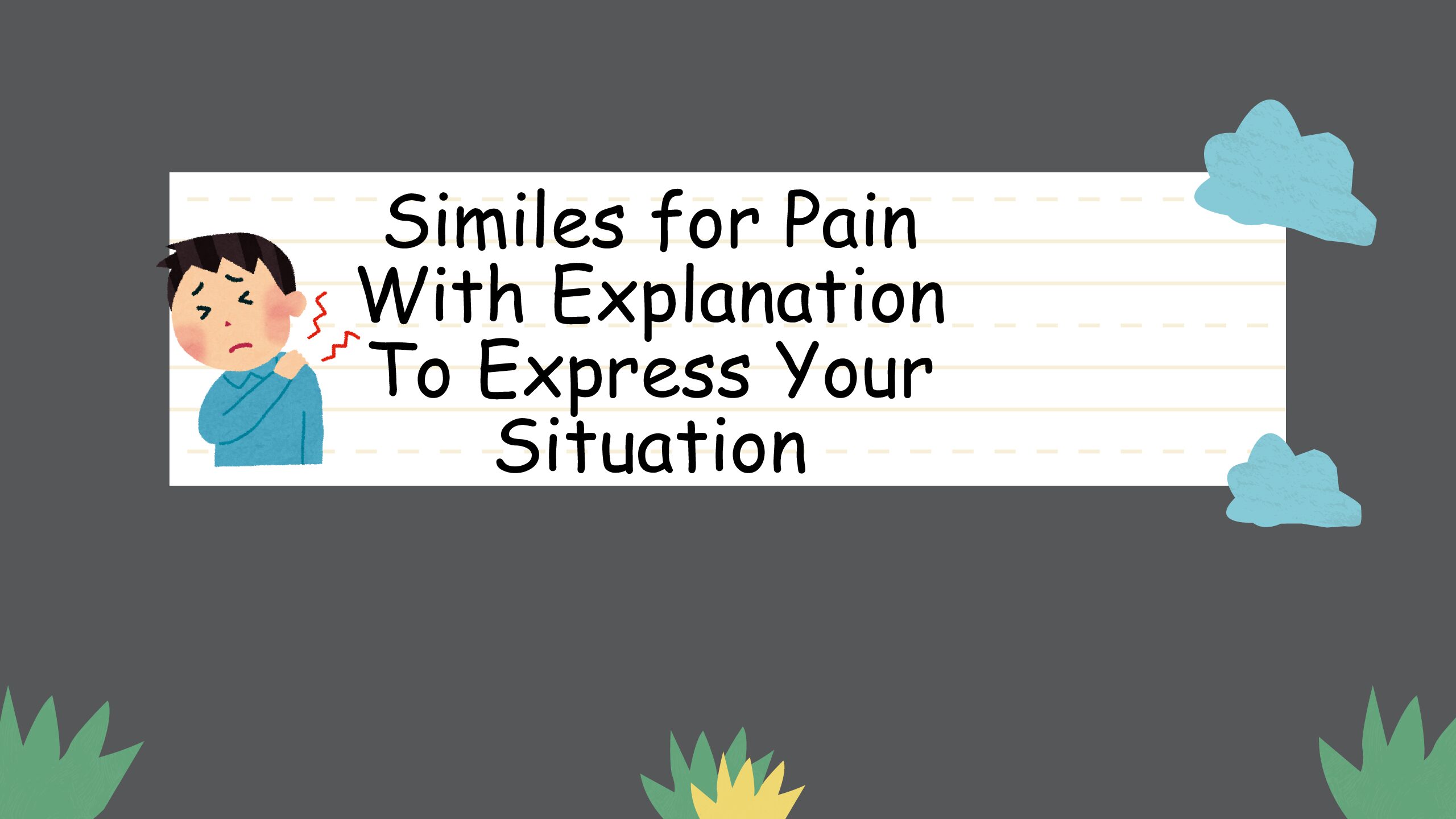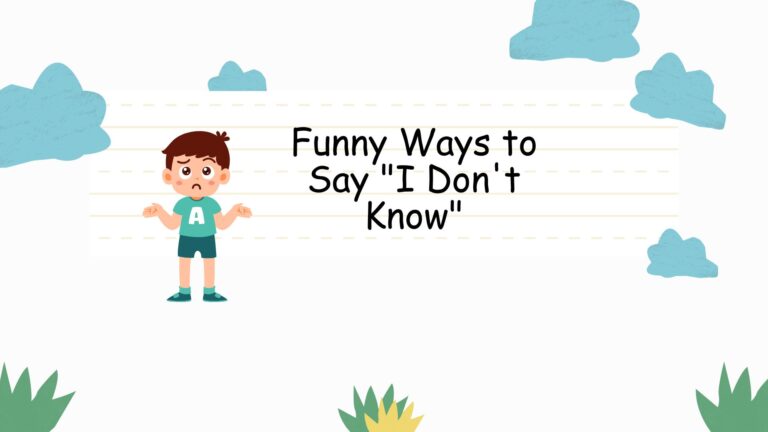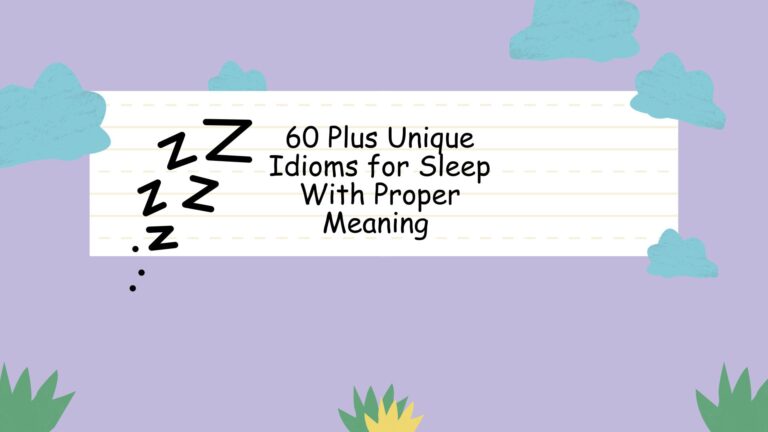
Similes for Pain With Explanation To Express Your Situation

Similes are powerful literary devices that enhance our ability to express complex emotions and sensations, particularly pain. Understanding and using similes effectively can dramatically improve both your writing and your comprehension of the English language. This article provides an in-depth exploration of similes for pain, covering their definition, structure, various types, usage rules, common mistakes, and advanced applications. Whether you’re a student, writer, or language enthusiast, this guide will equip you with the knowledge and skills to master this essential aspect of English grammar.
By the end of this article, you’ll be able to identify, analyze, and create compelling similes to describe pain in vivid and impactful ways. We’ll explore a variety of examples, practice exercises, and advanced techniques to solidify your understanding. Let’s embark on this journey to unlock the expressive potential of similes for pain.
Table of Contents
- Introduction
- Definition of Simile
- Structural Breakdown of Similes
- Types of Similes for Pain
- Examples of Similes for Pain
- Usage Rules for Similes
- Common Mistakes with Similes
- Practice Exercises
- Advanced Topics in Similes
- Frequently Asked Questions
- Conclusion
Definition of Simile
A simile is a figure of speech that directly compares two different things using the words “like” or “as.” Its primary function is to create a vivid image or convey a particular feeling by associating the subject with something more familiar or easily understood. Similes are crucial for adding depth and color to writing, making abstract concepts more concrete and relatable.
In the context of pain, similes allow us to express the intensity, quality, and emotional impact of physical or emotional suffering. By comparing pain to other experiences or objects, we can communicate its nature more effectively than simply stating “I’m in pain.” The effectiveness of a simile lies in its ability to evoke a strong sensory or emotional response in the reader.
For example, saying “The pain was like a hot knife being twisted in my gut” is much more descriptive and impactful than saying “I had a stomachache.” The simile uses familiar sensations to convey the specific characteristics of the pain, making it easier for the reader to understand and empathize.
Structural Breakdown of Similes
A simile consists of three main components: the subject, the linking word (like or as), and the object of comparison. Understanding these components is essential for constructing effective and grammatically correct similes.
Subject
The subject is the thing being described or compared. In the context of pain, the subject is often the pain itself or the sensation being experienced. This could be a specific type of pain, such as a headache, or a more general feeling of discomfort.
Linking Word
The linking word is either “like” or “as.” These words establish the comparison between the subject and the object. The choice between “like” and “as” is often a matter of personal preference, but both serve the same grammatical function.
Object of Comparison
The object of comparison is the thing to which the subject is being compared. This object should be something that the reader can easily understand and relate to. For similes describing pain, the object of comparison might be a physical object, an animal, a natural phenomenon, or another sensation.
Example: “The headache was like a vise squeezing my skull.”
- Subject: The headache
- Linking Word: like
- Object of Comparison: a vise squeezing my skull
The use of the word “like” creates a direct comparison between the headache and the sensation of a vise squeezing the skull. This structure allows the reader to understand the intensity and nature of the headache more effectively.
Types of Similes for Pain
Similes for pain can be categorized based on the type of comparison being made. These categories include physical sensations, emotional states, and abstract concepts. Understanding these categories can help you choose the most appropriate simile for a given situation.
Similes Comparing Physical Sensations
These similes compare pain to other physical sensations, such as burning, stabbing, or crushing. They are particularly effective for describing the intensity and quality of physical pain. For example, “The burn felt like a thousand needles pricking my skin” uses the sensation of needles to convey the sharpness and intensity of the burn.
Similes Comparing Emotional States
These similes compare pain to emotional states, such as grief, despair, or anxiety. They are useful for describing the emotional impact of pain, particularly when the pain is chronic or debilitating. For example, “The grief was like a heavy weight pressing down on my chest” uses the image of a heavy weight to convey the emotional burden of grief.
Similes Comparing Abstract Concepts
These similes compare pain to abstract concepts, such as time, darkness, or emptiness. They are often used to describe the psychological or existential aspects of pain. For example, “The pain stretched on like an endless night” uses the concept of an endless night to convey the feeling of relentless, unending pain.
Examples of Similes for Pain
The following tables provide a variety of examples of similes for pain, categorized by the type of comparison being made. These examples illustrate the diverse ways in which similes can be used to describe pain in vivid and impactful ways.
Examples Comparing Physical Sensations
This table shows similes that compare pain to other physical sensations. These are particularly useful for describing specific types of physical pain.
| Simile | Explanation |
|---|---|
| The pain was like a hot knife being twisted in my gut. | Conveys a sharp, intense, and agonizing pain. |
| It felt like my head was being split open with an axe. | Describes a severe headache with a splitting sensation. |
| The burn felt like a thousand needles pricking my skin. | Illustrates a sharp, stinging, and widespread burning sensation. |
| The pressure was like a vise squeezing my skull. | Depicts a constricting, intense pressure, often associated with headaches. |
| My muscles ached like they had been beaten with hammers. | Describes deep, throbbing, and widespread muscle pain. |
| The throbbing was like a drumbeat in my ear. | Conveys a rhythmic, persistent, and distracting throbbing sensation. |
| The cut felt like fire spreading through my veins. | Illustrates a burning, intense, and rapidly spreading pain. |
| The cramps were like a knot being tied in my stomach. | Depicts a twisting, constricting, and intensely uncomfortable pain. |
| The sting was like acid on my skin. | Conveys a sharp, burning, and corrosive sensation. |
| The ache was like a dull toothache in my bones. | Describes a persistent, nagging, and deep-seated ache. |
| The pain shot through me like an electric shock. | Illustrates a sudden, sharp, and jolting pain. |
| My joints felt like they were grinding together. | Depicts a grating, uncomfortable sensation, often associated with arthritis. |
| The discomfort was like sandpaper rubbing against my eyes. | Conveys a gritty, irritating, and persistent discomfort. |
| The itch was like ants crawling under my skin. | Illustrates a persistent, irritating, and unsettling sensation. |
| The cold was like tiny shards of glass stabbing my face. | Depicts a sharp, piercing, and intensely uncomfortable cold sensation. |
| My throat felt like it was filled with razor blades. | Conveys a sharp, cutting, and intensely painful sensation. |
| The pressure in my chest was like an elephant sitting on it. | Describes a heavy, crushing, and suffocating sensation. |
| The swelling felt like a balloon being inflated under my skin. | Illustrates a growing, tight, and uncomfortable sensation. |
| The pain was like a rusty nail being hammered into my skull. | Depicts a slow, grating, and persistent pain. |
| My back felt like it was breaking in two. | Conveys an intense, splitting, and debilitating pain. |
| The injury throbbed like a second heartbeat. | Illustrates a rhythmic, persistent, and distracting throbbing sensation. |
| The muscle spasm felt like a live wire twitching in my leg. | Depicts a sudden, uncontrolled, and intensely uncomfortable sensation. |
| The stiffness was like concrete setting in my joints. | Conveys a rigid, immovable, and restricting sensation. |
| The sensation was like pins and needles all over my body. | Illustrates a tingling, prickling, and widespread discomfort. |
Examples Comparing Emotional States
This table shows similes that compare pain to emotional states. These are useful for describing the psychological impact of pain.
| Simile | Explanation |
|---|---|
| The grief was like a heavy weight pressing down on my chest. | Conveys the burden and oppressiveness of grief. |
| The despair felt like a bottomless pit swallowing me whole. | Illustrates the feeling of hopelessness and being overwhelmed. |
| The anxiety was like a swarm of bees buzzing in my head. | Depicts a restless, agitated, and overwhelming sense of unease. |
| The loneliness was like a vast, empty desert surrounding me. | Conveys a sense of isolation, desolation, and emptiness. |
| The fear was like ice water running through my veins. | Illustrates a chilling, paralyzing, and intense feeling of fear. |
| The sadness was like a dark cloud hanging over my head. | Depicts a pervasive, gloomy, and oppressive feeling of sadness. |
| The regret was like a constant whisper in my ear. | Conveys a persistent, nagging, and haunting feeling of regret. |
| The guilt was like a chain binding me to the past. | Illustrates a restricting, burdensome, and inescapable feeling of guilt. |
| The shame was like a brand burning into my skin. | Depicts a searing, indelible, and deeply painful feeling of shame. |
| The anger was like a volcano erupting inside me. | Conveys a sudden, explosive, and destructive feeling of anger. |
| The frustration was like a tangled knot I couldn’t untie. | Illustrates a complex, persistent, and irritating feeling of frustration. |
| The disappointment was like a deflated balloon. | Depicts a sudden loss of hope, energy, and enthusiasm. |
| The heartbreak was like a shattered mirror. | Conveys a feeling of fragmentation, loss, and irreparable damage. |
| The trauma was like a ghost haunting my dreams. | Illustrates a persistent, unsettling, and inescapable feeling of trauma. |
| The stress was like a pressure cooker building inside me. | Depicts a growing, intense, and potentially explosive feeling of stress. |
| The vulnerability felt like standing naked in a blizzard. | Conveys a feeling of exposure, defenselessness, and intense discomfort. |
| The confusion was like navigating a maze in the dark. | Illustrates a feeling of disorientation, uncertainty, and helplessness. |
| The emptiness was like a void where my heart used to be. | Depicts a profound sense of loss, absence, and emotional numbness. |
| The paranoia was like a shadow following me everywhere. | Conveys a persistent, unsettling, and irrational feeling of being watched. |
| The jealousy was like a green-eyed monster consuming me. | Illustrates an intense, destructive, and overwhelming feeling of jealousy. |
| The resentment was like poison seeping into my soul. | Depicts a slow, corrosive, and deeply damaging feeling of resentment. |
| The apathy was like a thick fog clouding my mind. | Conveys a feeling of indifference, detachment, and emotional numbness. |
| The helplessness was like being trapped in quicksand. | Illustrates a feeling of being unable to escape, powerless, and overwhelmed. |
| The isolation was like living on a deserted island. | Depicts a profound sense of loneliness, disconnection, and abandonment. |
Examples Comparing Abstract Concepts
This table shows similes that compare pain to abstract concepts. These are often used to describe the psychological or existential aspects of pain.
| Simile | Explanation |
|---|---|
| The pain stretched on like an endless night. | Conveys the feeling of relentless, unending pain. |
| The suffering felt like an eternity compressed into a moment. | Illustrates the feeling of time distortion and intense, prolonged suffering. |
| The burden was like carrying the weight of the world on my shoulders. | Depicts an overwhelming sense of responsibility, pressure, and strain. |
| The struggle felt like climbing a mountain with no summit in sight. | Conveys a feeling of relentless effort, perseverance, and uncertainty. |
| The loss was like a piece of my soul being torn away. | Illustrates a profound sense of damage, fragmentation, and irreparable loss. |
| The healing process felt like watching grass grow in slow motion. | Depicts a slow, gradual, and often frustrating process of recovery. |
| The challenge was like solving a puzzle with missing pieces. | Conveys a feeling of complexity, incompleteness, and uncertainty. |
| The journey felt like wandering through a labyrinth with no exit. | Illustrates a feeling of disorientation, confusion, and being trapped. |
| The memory was like a faded photograph. | Depicts a sense of nostalgia, distance, and the passage of time. |
| The experience was like stepping into a different dimension. | Conveys a feeling of being transported to a new, unfamiliar, and often unsettling reality. |
| The change was like turning the page to a new chapter in my life. | Illustrates a sense of transition, renewal, and new beginnings. |
| The opportunity was like a door opening to a new world. | Depicts a sense of possibility, potential, and excitement. |
| The decision felt like walking a tightrope. | Conveys a feeling of risk, uncertainty, and the need for careful balance. |
| The commitment was like planting a tree that would take years to grow. | Illustrates a sense of long-term dedication, patience, and investment. |
| The relationship was like a dance that required two people to move in harmony. | Depicts a sense of interdependence, cooperation, and mutual respect. |
| The idea was like a seed planted in fertile ground. | Conveys a sense of potential, growth, and development. |
| The truth was like a light shining in the darkness. | Illustrates a sense of clarity, understanding, and hope. |
| The lie was like a shadow lurking in the corner. | Depicts a sense of deception, unease, and hidden danger. |
| The secret was like a weight I couldn’t share. | Conveys a feeling of burden, restriction, and isolation. |
| The silence was like a deafening roar. | Illustrates a sense of tension, unease, and unspoken emotion. |
| The absence was like a hole in my heart. | Depicts a profound sense of loss, emptiness, and emotional pain. |
| The past was like a map guiding my present. | Conveys a sense of influence, context, and the lessons learned from experience. |
| The future was like a blank canvas waiting to be painted. | Illustrates a sense of possibility, potential, and creative freedom. |
| The present was like a gift to be cherished. | Depicts a sense of gratitude, mindfulness, and appreciation. |
Usage Rules for Similes
Using similes effectively requires adherence to certain grammatical and stylistic rules. These rules ensure that the simile is clear, accurate, and impactful.
Clarity
The comparison should be clear and easy to understand. The reader should be able to immediately grasp the connection between the subject and the object of comparison.
Relevance
The object of comparison should be relevant to the subject. The comparison should highlight a specific characteristic or quality of the subject that is being emphasized.
Originality
While clichés can be effective in certain contexts, strive for originality in your similes. A fresh and unexpected comparison can be more impactful than a common one.
Consistency
Maintain consistency in tone and style within your writing. The simile should fit seamlessly into the overall context of the piece.
Grammatical Correctness
Ensure that the simile is grammatically correct. The linking word (“like” or “as”) should be used appropriately, and the subject and object should be properly connected.
Common Mistakes with Similes
Several common mistakes can undermine the effectiveness of similes. Avoiding these mistakes will help you create more impactful and grammatically sound comparisons.
Using Clichés
Clichés are overused similes that have lost their impact. While they may be easy to use, they often fail to create a vivid or original image. Instead of saying “The pain was like hell,” try something more specific and imaginative.
Incorrect: The pain was like hell.
Correct: The pain was like a searing iron pressed against my skin.
Mixing Metaphors and Similes
Metaphors and similes are similar, but they function differently. A metaphor states that one thing *is* another, while a simile uses “like” or “as” to make a comparison. Mixing the two can create confusion.
Incorrect: The pain was a knife, like it was twisting in my gut.
Correct: The pain was like a knife twisting in my gut. (Simile)
Correct: The pain was a knife twisting in my gut. (Metaphor)
Unclear Comparisons
The comparison should be clear and easy to understand. If the reader cannot grasp the connection between the subject and the object, the simile will be ineffective.
Incorrect: The pain was like a Tuesday.
Correct: The pain was like a dull, persistent ache that wouldn’t go away.
Inappropriate Comparisons
The object of comparison should be appropriate for the subject. Avoid comparisons that are illogical, offensive, or out of place.
Incorrect: The pain was like a rainbow.
Correct: The pain was like a sharp, stinging nettle.
Practice Exercises
Test your understanding of similes for pain with these practice exercises. Each exercise includes multiple questions with answers provided at the end.
Exercise 1: Identifying Similes
Identify the similes in the following sentences.
| Question | Answer |
|---|---|
| 1. The pain was like a swarm of bees stinging my arm. | like a swarm of bees stinging my arm |
| 2. Her grief was a deep ocean of sorrow. | (This is a metaphor, not a simile) |
| 3. The burn felt like fire spreading through my veins. | like fire spreading through my veins |
| 4. His heart was a stone in his chest. | (This is a metaphor, not a simile) |
| 5. The headache was like a hammer pounding in my head. | like a hammer pounding in my head |
| 6. The loneliness was like a vast, empty desert. | like a vast, empty desert |
| 7. The fear was ice water running through her veins. | (This is a metaphor, not a simile) |
| 8. The anxiety felt like a tangled knot in my stomach. | like a tangled knot in my stomach |
| 9. The memories were ghosts haunting his dreams. | (This is a metaphor, not a simile) |
| 10. The stress was like a pressure cooker building inside me. | like a pressure cooker building inside me |
Exercise 2: Completing Similes
Complete the following similes with an appropriate object of comparison.
| Question | Answer |
|---|---|
| 1. The pain was like ____. | a sharp knife |
| 2. The grief felt like ____. | a heavy weight |
| 3. The burn was as intense as ____. | the sun |
| 4. The ache was like ____. | a dull throbbing |
| 5. The fear was like ____. | ice in my veins |
| 6. The loneliness felt like ____. | an empty room |
| 7. The memory was like ____. | a faded photograph |
| 8. The stress was as constant as ____. | the ticking of a clock |
| 9. The guilt was like ____. | a chain binding me |
| 10. The anger was like ____. | a volcano erupting |
Exercise 3: Creating Similes
Create your own similes to describe the following types of pain.
| Question | Answer |
|---|---|
| 1. A headache | The headache was like a vise squeezing my skull. |
| 2. A stomachache | The stomachache was like a knot being tied in my gut. |
| 3. A burn | The burn felt like a thousand needles pricking my skin. |
| 4. Muscle soreness | My muscles ached like they had been beaten with hammers. |
| 5. Heartbreak | The heartbreak was like a shattered mirror. |
| 6. Anxiety | The anxiety was like a swarm of bees buzzing in my head. |
| 7. Loneliness | The loneliness was like a vast, empty desert surrounding me. |
| 8. Frustration | The frustration was like a tangled knot I couldn’t untie. |
| 9. Regret | The regret was like a constant whisper in my ear. |
| 10. Disappointment | The disappointment was like a deflated balloon. |
Advanced Topics in Similes
For advanced learners, exploring more complex aspects of similes can further enhance their understanding and usage of this literary device.
Extended Similes
An extended simile is a simile that is developed over several sentences or paragraphs. This allows for a more detailed and nuanced comparison.
Example: “The pain was like a storm raging within me. It started as a distant rumble, a faint unease that gradually grew into a deafening roar. The lightning of sharp, stabbing sensations flashed across my nerves, followed by the thunder of throbbing aches that echoed through my body. The rain of tears streamed down my face, washing away any hope of relief. And just when I thought the storm had passed, another wave of pain would crash over me, leaving me battered and exhausted.”
Subverted Similes
A subverted simile is a simile that intentionally defies expectations or common associations. This can create a surprising or humorous effect.
Example: “The pain was like a warm hug from a cactus.”
Similes in Poetry and Literature
Similes are frequently used in poetry and literature to create vivid imagery and convey complex emotions. Analyzing the use of similes in different literary works can provide valuable insights into their effectiveness.
Frequently Asked Questions
Here are some frequently asked questions about similes for pain, along with detailed answers.
- What is the difference between a simile and a metaphor?A simile is a comparison using “like” or “as,” while a metaphor states that one thing *is* another. Similes are explicit comparisons, while metaphors are implicit.
- How can I avoid using clichés in my similes?Strive for originality by thinking of specific and unusual comparisons. Consider the unique qualities of the pain you are describing and find objects or experiences that share those qualities.
- Can a simile be too long or too detailed?Yes, a simile can be too long if it becomes convoluted or distracting. Aim for a balance between detail and clarity. An extended simile can be effective if it is well-written and adds depth to the description.
- Is it better to use “like” or “as” in a simile?Both “like” and “as” are acceptable, and the choice often comes down to personal preference or stylistic considerations. In general, “like” is more common in informal writing, while “as” can sound more formal.
- How can I make my similes more impactful?Use vivid and sensory language, choose objects of comparison that are easily relatable, and focus on highlighting the specific qualities of the pain you are describing.
- Are similes only used to describe physical pain?No, similes can be used to describe emotional, psychological, or any other type of pain. The key is to find an appropriate object of comparison that effectively conveys the nature of the pain.
- How do I know if my simile is effective?Ask yourself if the simile creates a clear and vivid image in your mind. If it does, and if it accurately conveys the feeling or sensation you are trying to describe, then it is likely effective.
- Can I use multiple similes in a single sentence or paragraph?Yes, but use them sparingly and with purpose. Too many similes can become overwhelming and detract from the overall impact.
Conclusion
Mastering similes for pain is a valuable skill that can significantly enhance your ability to communicate effectively and creatively. By understanding the definition, structure, types, and usage rules of similes, you can craft vivid and impactful descriptions that resonate with your audience. Remember to avoid common mistakes, strive for originality, and practice regularly to refine your skills.
As you continue to explore the world of similes, consider analyzing the works of accomplished writers and poets to see how they use this literary device to create powerful and memorable images. With dedication and practice, you can unlock the full potential of similes and elevate your writing to new heights. The ability to articulate the nuances of pain, both physical and emotional, is a powerful tool for empathy, understanding, and connection.




